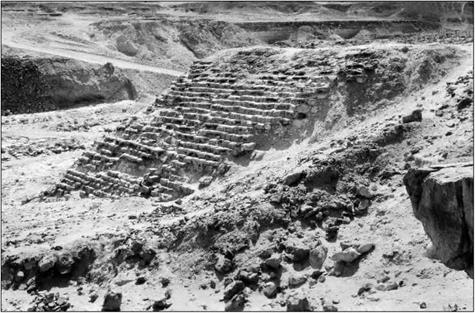Sadd el Kafara11: the first known large dam… and the story of its failure
In the IIIrd or IVth dynasty, about 2700 or 2600 BC, The Egyptians undertook the construction of a dam on an ephemeral tributary of the Nile, the wadi Garawi, some ten kilometers southeast of Memphis. This effort, coinciding with the period of construction of the great pyramids of Giza, is part of the development and improvement of the region around the capital. The remains of the dam are still visible today on both banks of the wadi, and were studied in 1982 by a Germano-Egyptian team.[97]
The dam comprises two rock faces with central core of random material. The upstream and downstream faces are protected by cut blocks forming steps of about 30 cm in height (Figure 3.3). It is the length (113 m) and especially the height (14 m) of this structure that earn its recognition as the oldest known large dam. Even more surprising is the dam’s colossal thickness, nearly 100 m wide at the base and 66 m at the crest. This excessive thickness shows that dam techniques were still somewhat primitive in Egypt of the IIIrd millennium BC.
|
|
Figure 3.3 Remains of the Sadd el Kafara dam (about 2600 BC), on the right bank of the wadi Garawi. The oldest known large dam. View from upstream (photo of G. Garbrecht)
|
Figure 3.3a Cross section of the structure of the Sadd el Kafara dam on the wadi Garawi. The outside blocks form about 30 stairsteps. After Garbrecht (1985). |
The most likely purpose of this dam was to protect downstream cultivated and inhabited areas riparian to the Nile from the violent floods of the wadi Garawi. Indeed, the structure’s permeable core argues against the hypothesis of a reservoir to store water for agricultural use. In any case, irrigation in Egypt at this period remains entirely based on floods of the Nile. Curiously, examination of the reservoir area shows no trace whatsoever of sedimentation, suggesting that it was not the destiny of this important dam to survive very long.
We have already mentioned that the wadi Garawi is normally dry but can have violent floods. Its bed slope is fairly steep at about 10 m per kilometer, and the flood discharge can be estimated at between 50 and 250 m3/sec. The storage capacity of the reservoir (620,000 m3) is insufficient to capture all the water of a large flood. On the left bank, there is a terrace whose elevation is 1.5 m below that of the dam crest. This terrace therefore can serve as a natural spillway, whether or not this was intended by the dam’s designers. The spillway has a capacity of the order of 85 m3/sec, beyond which flow the dam can be overtopped. Given its broad dimensions and rock protection, the dam should have been able to resist partial overtopping. These analyses led Gunther Garbecht to hypothesize that the dam failed before it was completely finished, when the upstream rock face had been built to its nominal height but neither the downstream face nor the filling of the core were completely finished. Submerged by an exceptional flood, the dam could have been ruined by erosion of the central core and collapse of the upstream face. This failure would surely have resulted in downstream destruction, and the memory of this catastrophe could explain the absence of new dam construction in Egypt for many centuries to come.








Leave a reply